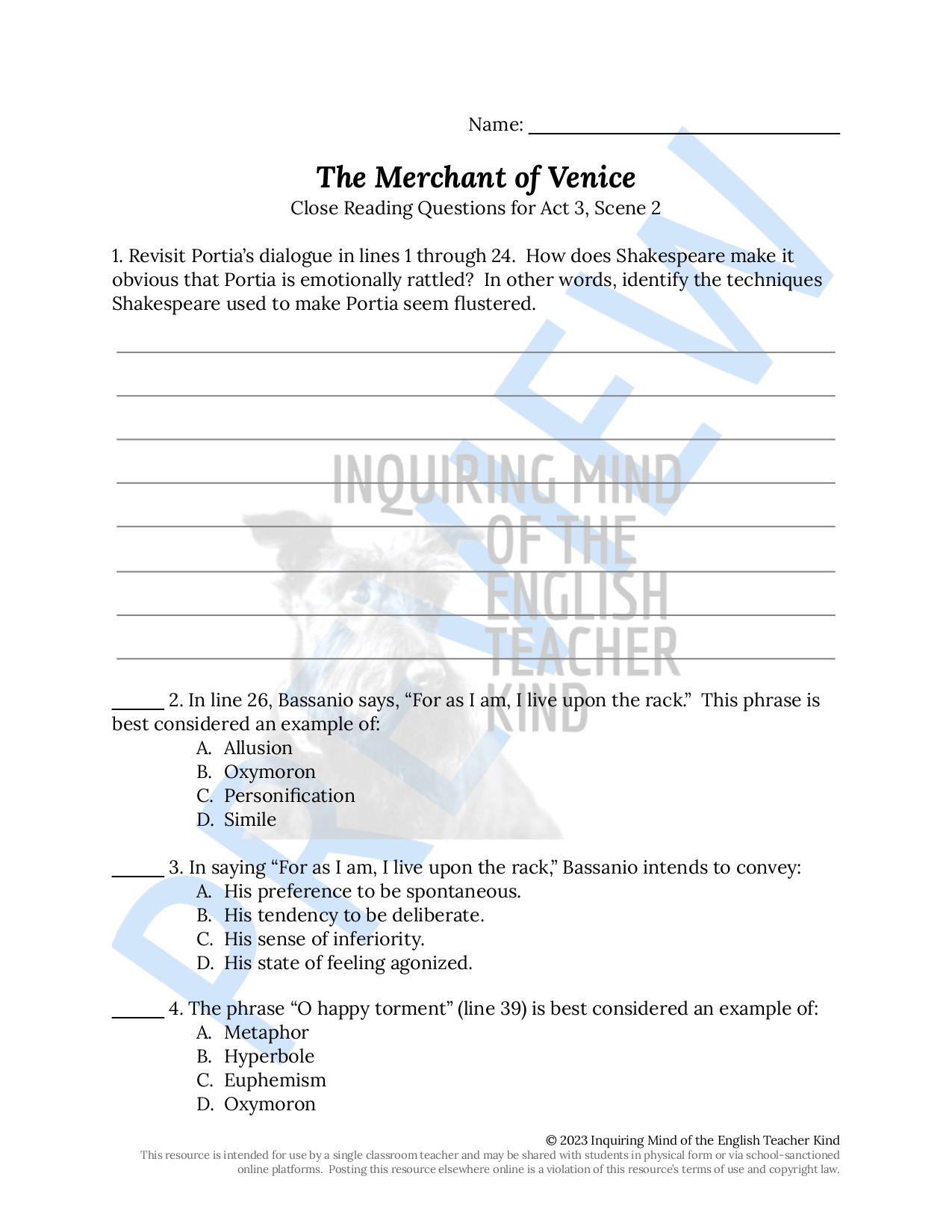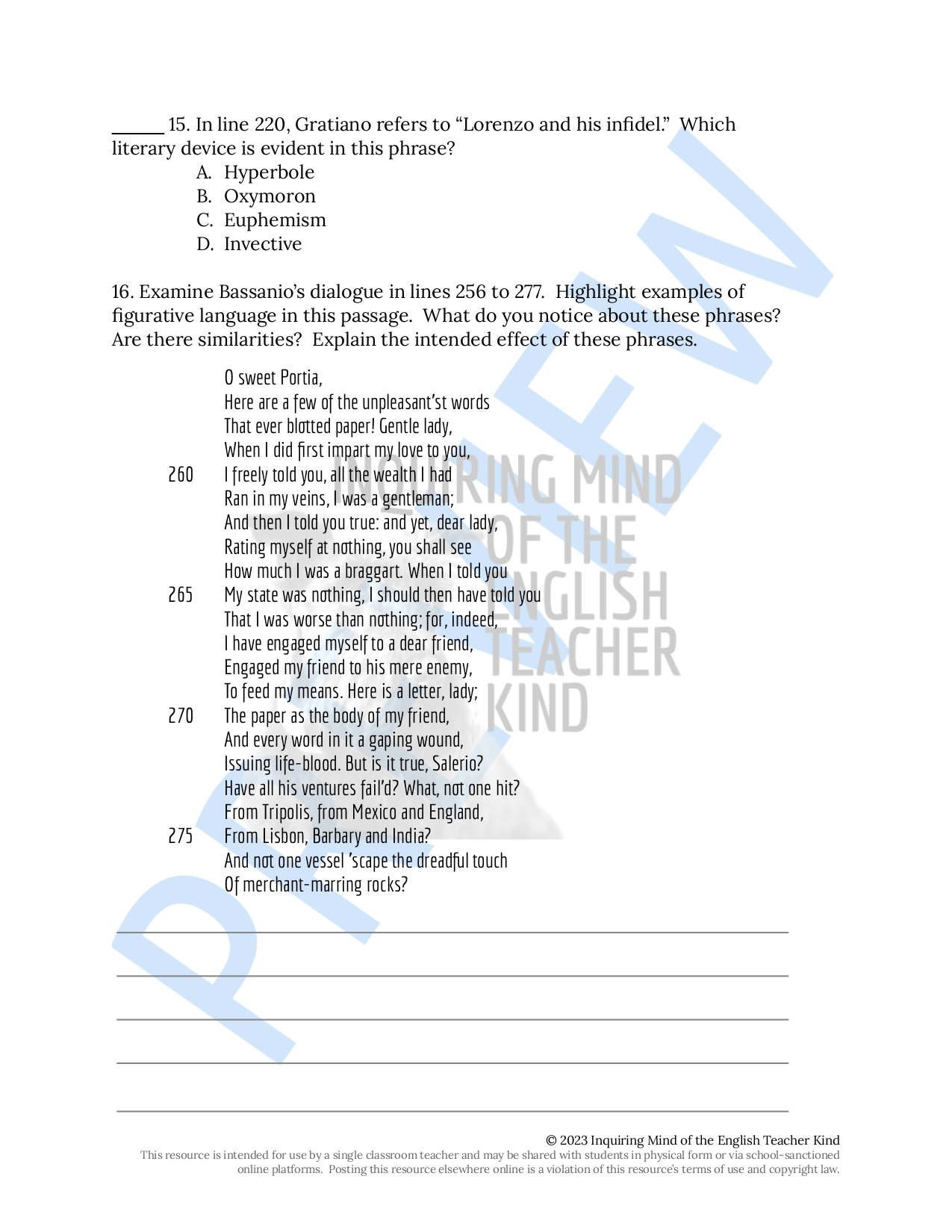





Extend reading comprehension and support the development of close reading analysis skills for high school with this set of rigorous questions about Shakespeare’s The Merchant of Venice. Focusing on Act 3, scene 2, this resource is delivered in editable Word Document and printable PDF formats. An answer key is included. Specifically, students will:
- Identify what the text states explicitly and implicitly
- Examine narrative techniques used to make Portia seem emotionally flustered
- Explore how characters think, behave, develop, and interact
- Isolate an opinion with which Bassanio would most likely agree
- Discern the tone of a given passage
- Isolate a false statement from a set of true statements
- Analyze the author’s craft with emphasis on the effect created by the incorporation of figurative language
- Apply knowledge of various literary devices including oxymoron, onomatopoeia, allusion, personification, symbolism, invective, and more
- Make a logical inference based on the rhyme scheme of a featured song
- Write ideas with accuracy, clarity, and precision
- Defend claims with reasoned thinking and textual evidence
Get this resource as part of a bundle and save up to 28%
A bundle is a package of resources grouped together to teach a particular topic, or a series of lessons, in one place.
The Merchant of Venice Close Reading Analysis Worksheets Bundle
Use this bundle of rigorous close reading resources to help high school students extend reading comprehension and analyze plot developments over the course of William Shakespeare’s *The Merchant of Venice*. Answer keys are included. Covering every single scene in the play, this bundle offers 20 editable worksheets designed to facilitate students’ abilities to do the following: * Identify what the text states explicitly and implicitly * Define complex words and phrases as they are used * Explore how complex characters think, behave, develop, and interact * Examine how Shakespeare’s character choices affect the audience * Isolate opinions with which characters are likely to agree * Examine narrative techniques used to make Portia seem emotionally flustered * Consider the motif of the guest-host relationship and argue whether Portia conforms to the expectations of a good host, or whether she fails to meet expectations and represents a bad host * Compare and contrast characters (Antonio and Shylock; Portia and Antonio; Jessica and Portia) * Apply knowledge of many literary devices with emphasis on metaphor, oxymoron, onomatopoeia, allusion, personification, symbolism, invective, euphemism, juxtaposition, hyperbole situational irony, and dramatic irony * Conduct brief online research (if necessary) to determine the symbolic value of a particular object * Determine the functions of given passages * Discern the tone of several passages * Explore how Shakespeare creates suspense * Explore themes * Explore cause-and-effect relationships * Come to class/leave class better prepared to discuss the play * Defend claims with reasoned thinking and relevant evidence * Write ideas with accuracy, clarity, and precision
The Merchant of Venice Act 3 Quiz and Close Reading Bundle
Help high school students extend reading comprehension and analyze plot developments in Act 3 of William Shakespeare's *The Merchant of Venice* with this bundle of assessments. Answer keys are included. Covering every scene in Act 3, this bundle offers a plot-based quiz and five close reading analysis worksheets designed to facilitate students' abilities to do the following: * Identify what the text states explicitly and implicitly * Define complex words and phrases as they are used * Explore how complex characters think, behave, develop, and interact * Isolate opinions with which characters are likely to agree * Examine narrative techniques used to make Portia seem emotionally flustered * Compare and contrast two characters (Antonio and Shylock; Portia and Antonio) * Apply knowledge of many literary devices with emphasis on metaphor, oxymoron, onomatopoeia, allusion, personification, symbolism, invective, and euphemism * Analyze the author's craft with emphasis on the effect created by the incorporation of active verbs * Explore themes * Come to class/leave class better prepared to discuss the play * Defend claims with reasoned thinking and relevant evidence * Write ideas with accuracy, clarity, and precision
Something went wrong, please try again later.
This resource hasn't been reviewed yet
To ensure quality for our reviews, only customers who have purchased this resource can review it
Report this resourceto let us know if it violates our terms and conditions.
Our customer service team will review your report and will be in touch.